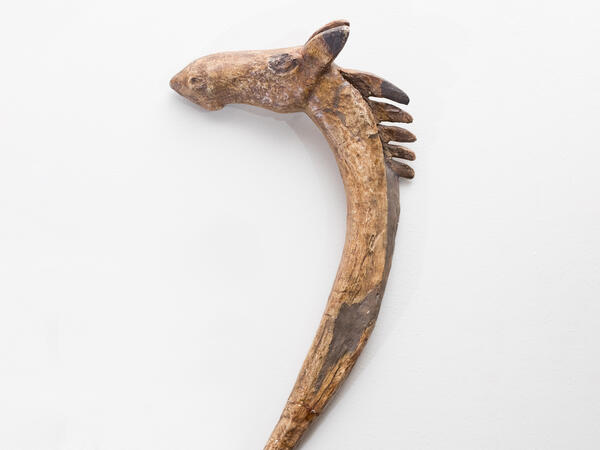The museum houses a copy of a rare find dating to the Mesolithic era from the Oleneostrovsky burial ground in Karelia — a shaman’s staff with a handle in the form of an elk’s head. A shaman’s staff and a tambourine were believed to act as mediators between the world of people and spirits. This is not the only artifact of this kind in the museum’s funds. Here you can also see other archaeological finds: tools discovered at the ancient sites of Karelia, tools from stone processing workshops, restored vessels of the New Stone Age, cult objects and amulets from burials, and granite slabs with mysterious rock drawings (petroglyphs) from the eastern coast Lake Onega.
The find that was copied was from the excavations of the Leningrad archaeologist Vladislav Ravdonikas. In 1937, his team worked within the Oleneostrovsky burial ground on South Deer Island and discovered this item in one of the burials. A man and a woman were buried in the grave. The handle was near the man’s head, who was lying in the traditional burial position: on his back with his elbows bent.
Initially, the burial ground was dated to the 2nd millennium BC, and then it turned out that it was older — about 8 thousand years old. The handle of the staff dates back to the 6th millennium BC (Mesolithic era).
The burial also contained amulets-pendants made from elk and beaver incisors and a bone arrowhead. The handle, pointed downwards, with the handle in the form of an animal’s head, is probably a ritual image of a totem — a female elk with a fluttering mane. The original handle, made of elk antlers, is kept in the Museum of Ethnography and Anthropology of the Russian Academy of Sciences named after Peter the Great (Kunstkamera).
Nowadays, the Oleneostrovsky burial ground is the only burial site of the Mesolithic era in Northern Europe. The bones of the dead and a set of objects that, in the opinion of fellow tribesmen, the deceased could use in the kingdom of the dead, have been well preserved. Handles and amulets, hunting and fishing tools, carved figures of people, animals, filigree pendants made of bear fangs and other items were found in the graves — more than 7,000 items in total.
The find that was copied was from the excavations of the Leningrad archaeologist Vladislav Ravdonikas. In 1937, his team worked within the Oleneostrovsky burial ground on South Deer Island and discovered this item in one of the burials. A man and a woman were buried in the grave. The handle was near the man’s head, who was lying in the traditional burial position: on his back with his elbows bent.
Initially, the burial ground was dated to the 2nd millennium BC, and then it turned out that it was older — about 8 thousand years old. The handle of the staff dates back to the 6th millennium BC (Mesolithic era).
The burial also contained amulets-pendants made from elk and beaver incisors and a bone arrowhead. The handle, pointed downwards, with the handle in the form of an animal’s head, is probably a ritual image of a totem — a female elk with a fluttering mane. The original handle, made of elk antlers, is kept in the Museum of Ethnography and Anthropology of the Russian Academy of Sciences named after Peter the Great (Kunstkamera).
Nowadays, the Oleneostrovsky burial ground is the only burial site of the Mesolithic era in Northern Europe. The bones of the dead and a set of objects that, in the opinion of fellow tribesmen, the deceased could use in the kingdom of the dead, have been well preserved. Handles and amulets, hunting and fishing tools, carved figures of people, animals, filigree pendants made of bear fangs and other items were found in the graves — more than 7,000 items in total.



